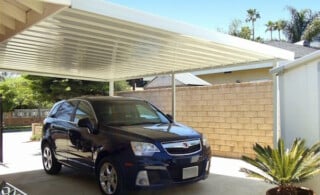
If you drive a car, you’ll have many concerns and responsibilities. From being able to change a flat tire to knowing what to do if your car won’t start, you’ll need to be prepared for any situation and have a car emergency checklist as well as making sure that you’ve found good garage door contractors near you and nearby driveway paving companies to maintain where you keep your vehicle. You should also consider assembling an emergency car kit to keep in your vehicle for optimal car safety. Knowing how to respond readily to potential problems will keep you in the driver’s seat.
Mechanical and Recovery Car Kit Items
Often, you can avoid car trouble with preventative maintenance such as:
- changing your oil,
- topping off fluids,
- changing your air filter, and
- rotating your tires.
But even when you’re careful to keep your vehicle maintained, you may still experience a roadside emergency with an issue such as a flat tire, a broken windshield, or running out of gas. If you have a basic understanding of car repair and you keep tools in your vehicle, you may be able to take care of some issues yourself.
- Car jack and spare tire: A flat tire comes in near the top of the list of roadside emergencies. Every driver should know how to change a tire, and you must also carry the tools you’ll need to do so. Know where the spare tire is and how to get to it and carry a jack with you.
- Jumper cables: If you accidentally leave the lights on, you may return to a dead battery in your car. Carrying jumper cables will enable you to jump-start your car with the help of another driver. Ideally, your jumper cables should be at least 20 feet long with the correct cable gauge for the car.
- Emergency car battery charger: For those times when you’re stranded without someone to give you a jump-start, carrying a car battery charger will enable you to recharge your battery with enough power to get you to the next city.
Emergency and Survival Car Kit Items
If you’re ever stranded in your car, a survival kit can make the difference between life and death. Make sure you pack these important items in your car.
- Fire extinguisher: Keeping a fire extinguisher within easy reach of the driver’s seat will enable you to extinguish a gas or diesel fire.
- Car escape tool or pocket knife: A tool that enables you to cut through a seat belt and break a window to escape is also important.
- Two-way radio: Carry a two-way radio in your car for emergencies. With a range of more than 20 miles and long battery life, it’ll help you if your phone doesn’t work and you need to call for help.
As you assemble the items for your car kit, make sure you add these items for a full car emergency kit:
- Canvas bag to hold the kit
- Gas can (no-spill style)
- Jumper cables
- Flat tire inflation canister
- Spare tire
- Jack
- Maps
- Car fuses
- First aid kit
- Flashlight
- Shovel
- Car escape tool
- Fire extinguisher
- Antifreeze
- Extra motor oil
- Duct tape
- Paper towels
- Washer fluid
- Pens and paper
- Multipurpose tool
- Rain gear
- Ice scraper
- GPS unit
- Towing strap
- Cell phone charger
- Car battery charger
- Flares or glow sticks
- Battery-powered radio
- Extra winter outerwear
- Blankets and sleeping bags
- At least two to three gallons of bottled water
- Granola bars or other non-perishable snacks
- Tool kit with screwdrivers, pliers, wrenches, and tire gauge
- Personal sanitation items (hand sanitizer, towelettes, etc.)
Safe Driving Tips for Bad Weather
Driving on Snowy or Icy Roads
- Slow down: Drive about 10 miles per hour slower, even if you have all-wheel drive.
- Look out for black ice Black ice is invisible, so be prepared for it on bridges, in shadows, and at intersections.
- Don’t tailgate: Leave at least 100 yards between you and the vehicle ahead of you so you can stop.
- Don’t brake while turning: Slow down before you turn to avoid spinning out.
- Turn into skids: If you start to skid, release the brake and gas and steer the car in the direction it’s skidding.
Driving in Foggy Conditions
- Use fog lights: Turn on your fog lights to cut through the fog better.
- Pump the brakes as a warning: If you enter a fog bank, pump the brakes as you drive into it so cars behind you are prepared.
- Slow down before hills: Reduce your speed before you crest a hill so that you’re prepared for what you can’t see ahead of time.
Driving in Rainy Weather
- Slow down: Reduce your speed by up to 10 miles per hour to avoid hydroplaning.
- Don’t drive through water: Avoid standing water because it could be deeper than it looks and cause your car to stall.
- Dry the brakes: After driving through a puddle, take your foot off the gas and brake lightly to dry the brakes.
Having Car Trouble?
- Get the car out of traffic: Pull off the road and illuminate your hazard lights. Place flares around the car for optimal visibility for other drivers.
- Don’t leave the car: Stay in your car until someone arrives.
- Dig yourself out of snow: If you’re stuck in snow, use kitty litter, sand, or even your floor mats under the tires to improve traction. Use your shovel from your survival kit to dig out around the wheels and around the exhaust pipe to prevent carbon monoxide poisoning.
Prep Your Car for Bad Weather
- Maintain the windshield wipers: Replace wipers regularly to ensure that they’re working properly.
- Clean the headlights: Headlight covers will turn cloudy over time. Purchase a kit to clean them.
- Check the tires: Insert a penny so the top of Abraham Lincoln’s head goes first into a tire groove. If you can see the top of his head, your tires are too worn. Check the tire pressure, too.
- Get winter car service: If you live where it’s cold during the winter, ask about garage contractors near me and have your car serviced before the snow flies.
- Keep an emergency kit: Always drive with a fully stocked emergency kit in your trunk.
More Sources:
- Control a Skidding Car: Winter Driving Skills: Learn how to steer if your car goes into a uncontrolled skid.
- Winter Driving Tips: Proper tire inflation is very important during the winter.
- Ten Safe Driving Tips When Fog Rolls In: Keep your windshield as clear as possible during fog.
- Five Tips to Remember for Driving Safely in the Rain: Drive with your headlights on in the rain.
- What to Do if You Get Stranded in Your Vehicle During a Snowstorm: If you are stranded in your car during a snowstorm, don’t leave your car.
- What to Do if Your Vehicle Breaks Down: Follow these steps to keep yourself safe and get help with your car.
- What Should You Keep in Your Car? Check your emergency kit every six months to make sure the items are in good condition.
- How to Create Your Own Emergency Roadside Kit: Your emergency kit can make the difference between severe hardship and inconvenience.
- 15 Steps for Changing a Flat Tire: Test your equipment before you need it so you know that it works.
- How to Change a Car Tire: Make sure it’s safe to change your tire before you begin.
- Four Car Fluids You Should Check Before Winter: Check the brake fluid, antifreeze, transmission fluid, and oil before winter arrives.
 Comparing the Pros and Cons of an Attached and Detached Garage
Comparing the Pros and Cons of an Attached and Detached Garage  Protect Your Garage With Garage Door Insulation
Protect Your Garage With Garage Door Insulation  Garage Doors
Garage Doors  Garage Remodeling Prep Steps
Garage Remodeling Prep Steps  Carports
Carports 

Are You Familiar With This Topic? Share Your Experience.